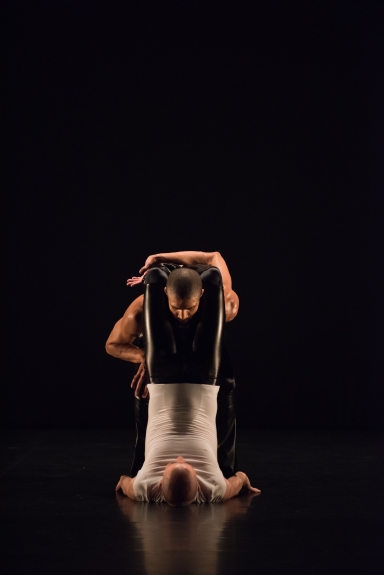Barbican Theatre, London
October 12, 2016
Róisín O’Brien
Presenting that unique wiggle around classical ballet, Michael Clark’s to a simple rock ‘n’ roll…song is a sophisticated mastering of a particularly unique creative vision. But perhaps ‘sophisticated’ should never be comfortably applied to Clark, as the evening’s orange unitards and leather gloves would argue.
The evening is divided into three distinct acts that nonetheless develop and vary similar material. Act I, ‘Satie Studs/Ogives Composite’, is Clark’s homage to Erik Satie and the many choreographers who have worked with his music. It is hard to not see Cunningham’s influence the most. While much of Cunningham’s work can be read through his self professed love of movement, lending the pieces an often ebullient air as the dancers twist, tilt and triplet, Clark’s dancers have instead a surreal, slightly off kilter feel. Their carefully articulated, extended limbs in monochromatic costumes, slashed against block coloured backgrounds, tick past, moving from upheld structures to exquisitely twisted floor shapes. There are a few wobbles, which jolt the audience out of the serenity of the piece, but Clark ultimately proves himself a master of shape. The music is allowed space to breathe, as the dancers gracefully pause at the quieter moments.

to a simple, rock ’n’ roll…song (LAND)
Photo Hugo Glendinning
Act II, ‘Land’, opens with the cast in black unitards finished with leather flares, and a stark black backdrop. The dancers come into their element here, rolling and grooving to Patti Smith’s snarls. There is a certain itch or frustration in the movement, amplified by the digital projections that disconcertingly spin between spirals of cascading numbers and pulsating white circles. The piece looses interest when the dancers purely work through classical steps: rather, it is the inclusion of contrasting moments where hands reach between legs and grasp the backs of the thighs, that show Clark’s subtle but exact play between restriction and freedom.
Entering the theatre for Act III, ‘my mother, my dog and CLOWNS!’, Under Pressure plays on a xylophone quietly. The lights take their time to dim, the music and the memory of Bowie intruding softly into people’s conversations. Curtains up, the reoccurrence of Clark’s style initially appears slightly cold and mechanical.
It is in the bizarre, more playful moments that Act III finds its footing, with its stellar black then shimmering orange costumes and outer-space soundtrack. Clark’s brief entrances come with a knowing smirk, as he flits in and out of the curtain, hands outstretched, a prophet with an offering. Later, he shoos one of his dancers away with his leather gloves. He is the creator, both present and absent, both the evening’s performance and the weight of his own history.
The dancers zip around, their hips rolling, alien and juicy, before each classical lunge. Their precise, perfectly executed jazzy clicks aptly end a night of carefully choreographed contradictions and oddities.

